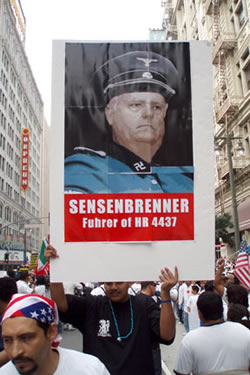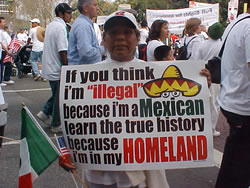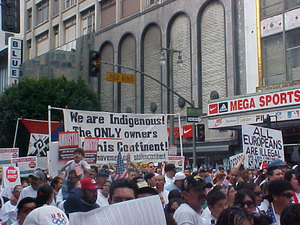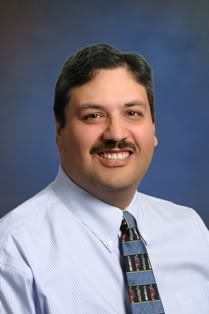Must it also be repeated? Newfound documents confirm old ties linking terrorism, weapons of mass destruction, and Saddam | Mindy Belz
There they sit. Forty-eight thousand boxes containing thousands upon thousands of documents from the Saddam Hussein regime stacked variously to the heavens, entirely filling a desert warehouse where Central Command has its headquarters in Qatar—a message in a bottle writ as large as Wal-Mart. Three years since U.S. soldiers swept into Baghdad and began collecting pages out of Saddam's playbook on a regime allegedly involved in terrorism, in propagating weapons of mass destruction, and in plotting deadly war against the United States, that regime's written and audiotaped record remains largely unexamined, barely translated, and—until this month—grossly underestimated.
Faced with mounting pressure from Congress and the media to allow public access to some of the estimated millions of printed records and over 500 hours of audiotape, Director of National Intelligence John Negroponte agreed March 16 to release select documents. Within days the directorate posted 125 separate items at its Foreign Military Studies Office website (fmso.leavenworth.army.mil/products-docex.htm) and added to a roster of terrorism-related documents already available in a West Point database (www.ctc.usma.edu/harmony_docs.asp).
The documents are a hodgepodge, the detritus of ponderous recordkeeping from a dictatorship obsessed with management and control. (And these are the papers that didn't face the shredder as the 3rd Infantry Division moved toward Baghdad.) There are land surveys and high-level discussions of transferring property to tribal heads friendly to Saddam so that they, in turn, could transfer land to their cronies; audiotapes of Saddam discussing military strategy in the Iran-Iraq War; videotape of Saddam greeting various heads of state; a memo on cooperative exchange of military officers with Vietnam; Saddam talking about Iraqi folk songs; Saddam giving an interview to ABC; Saddam at a military air show, and so on.
Sorting wheat from chaff is "long, slow, and tedious, but this is what intel is," said Bill Tierney, an Army linguist who helped jumpstart the document dumping in February by publicizing 12 hours of Saddam on tape he had translated from Arabic to English. The recordings, released at the national Intelligence Summit in Washington last month, include Saddam discussing a previously undisclosed nuclear weapons program and promising in the mid-1990s that the United States would be visited in the future by "terrorism with weapons of mass destruction." This latest set of disclosures, Mr. Tierney told WORLD, "is a haystack. And there are definitely jewels hiding in it, but it is difficult to find them."
Many analysts blame the CIA and the Defense Intelligence Agency for stashing the documents in the desert while the president battles feverishly to close a credibility gap over his reasons for going to war. At the same time, House Intelligence Committee chair Pete Hoekstra (R-Mich.) and Sen. Rick Santorum (R-Pa.) had to introduce legislationcompelling the intelligence community to release documents before Mr. Negroponte would agree to it. But if the intelligence community is launching the public on a paper chase just to satisfy key lawmakers and a smattering of noisy experts like Mr. Tierney, important discoveries already are surfacing, anyway.
Exhibit A
One file from 1987 consists of extensive letters between Iraq's military intelligence (or Mukhabarat) and Saddam Hussein, confirming for the first time that Saddam himself ordered chemical weapons attacks against villages in northern Iraq. Those attacks began on a few dozen villages in April 1987 but culminated in the worst attack, in March 1988, on Halabja, a town of 70,000 where 5,000 reportedly died from poison gas over three days. Overall, approximately 12,000 are believed to have died from the attacks, commonly attributed to orders from Ali Hassan al-Majid, or "Chemical Ali."
One memo in the file informs the president that plans for chemical attack "have been readied. Weapons in Kurdish villages in the north and northeast are ready." It describes specific loads of sarin and mustard gas and prescribes targeted villages. It warns that "explosion of these chemicals will create clouds and the troops should not move before the clouds have settled." According to Walid Phares, senior fellow at the Foundation for the Defense of Democracy, whom WORLD asked to translate the file, after the president gives the OK, the Mukhabarat chief promises Saddam the attacks "will not only reach target but will reach another objective."
Mr. Phares, a Middle East scholar who teaches at Florida Atlantic University, is fluent in Arabic and three other languages and is familiar with Iraqi documents (see "Unmasked men," Oct. 16, 2004). He told WORLD: "This is a direct order of chemical attacks." Statements in one memo from Saddam state that "special equipment is in full production" and "our production is increasing." The assurances suggest that the chemical program was an integral part of Iraq's military apparatus, not a scientific/civilian offshoot as it would later be portrayed during UN weapons inspections in the 1990s.
"Between his chemical and nuclear capabilities, you may argue about his nuclear capabilities, but with this you cannot argue about his chemical capabilities," Mr. Phares said. If only Iraq's judiciary had known before it spent months and months trying to bring Saddam to trial over the killings of a few dozen Iraqis in a Shiite suburb.
Exhibit B
Nuclear capabilities became a topic of discussion in a 1995 meeting with Saddam, vice president Tariq Aziz, and top military officials. An incomplete audiotape of the meeting runs over 62 minutes and begins with Saddam, Mr. Aziz, a Lt. Gen. "Amir" and others discussing how to dodge and parry their way through an upcoming report to the UN Security Council from UN weapons inspector Rolf Ekeus. "Sir . . . one could be suspicious of it [the Biological Program] if we concentrate on it [UNINTELLIGIBLE] and the trafficking effort and dodging everything in regards to it," a nervous Lt. Gen. Amir explains.
Throughout the meeting the top brass comes off as the frustrated but dutiful victim of oppressive UN sanctions, when in fact the Iraqi leaders are rehearsing their way out of full compliance with UN resolutions. Much of the give and take is about how closely to rely on the French and the Russians to counter the Americans and the British at the Security Council level. Then Hussein Kamal, Saddam's son-in-law, interrupts uncomfortably: "On the nuclear file, Sir, we are saying that we disclosed everything? No, we have undeclared problems in the nuclear field, and I believe that they know them. Some teams work and no one knows some of them. Sir, I am sorry for speaking so clearly. Everything is over. But, did they know? No, Sir, they did not know; not all the methods, not all the means, not all the scientists, and not all the places."
About that time UN weapons inspectors were taken to a facility in the western desert, where they were shown proof Iraq had tested a nuclear weapon (a chapter now overlooked in both Iraq Survey Group reports and the media). Mr. Kamal would, only weeks later, defect to Jordan where he gave fresh evidence of an Iraq WMD program to UN inspectors, before deciding to return to Baghdad, apparently regretting the prospect of permanent separation from his family. Six months after the defection he was assassinated in Iraq.
Mr. Tierney worked as a translator and interrogator for the UN weapons inspection team at that time. He told WORLD, "In the beginning the Iraqis would give full, final, and complete declaration and the inspectors would go to verify it. 'Material balance' was the key phrase we used, and it depended on the documents being accurate and complete. After Hussein Kamal, we had the issue of defectors—who could we trust? But in fact a significant percentage of defectors were providing accurate information. It began to look like inspections could go on ad infinitum. This posed a problem for the French and Russians, who already had contracts lined up with the Iraqis. It also posed a problem for the Clinton administration, which wanted a Middle East peace treaty, and Iraq would not go away." The issue of nuclear capability was allowed to remain a question mark.
Exhibit C
Anglo-American human shields take note: Saddam had your idea first. In a March 14, 2003, memo marked "Secret and Personal," Qusay Hussein, acting on his father's orders and as head of the Republican Guard, ordered "448 captured Kuwaitis" transported from three prisons "to make them human shields at all locations that are expected to be attacked by the criminal Anglo-American aggressors."
Exhibit D
A handwritten dossier dated Aug. 17, 2002, confirms an operational cell of al-Qaeda inside Iraq and identifies its key member as Ahmed Fadil Nizal Al Khalaylah—also known as Abu Musab al-Zarqawi, the current leader of al Qaeda in Iraq. Saddam's regime, from the document, seems little concerned about the terrorist's presence—even though tolerating known terrorists violated UN resolutions—and less surprised, perhaps with reason. Another memo, dated Sept. 15, 2001, and from Afghanistan, notes a relationship between al Qaeda in Afghanistan and Baghdad, and a Dec. 1, 2001, memo reports on "the status of rumors" of 3,000 Fedayeen Saddam from Anbar Province who were dispatched "in an unofficial capacity to Afghanistan and have joined the mujahidin to fight with and aid them in defeating the American Zionist Imperialist attack."
Those admissions are news only to those who believe the U.S. invasion is responsible for the Iraq/al-Qaeda convergence. Documents already publicized by WORLD show Saddam's regime providing terrorist training and financial support against U.S. forces in Somalia after the Gulf War, and in Egypt, Sudan, Yemen, and elsewhere.
In 2002, when Kurdish forces captured 16 al-Qaeda men crossing the border from Iran, the Kurds convinced only three publications (The New Yorker, The Christian Science Monitor, and WORLD) to send reporters to investigate their stories and failed to persuade the CIA to interview the detainees. One of them, Iraqi Haqi Ismail, was trained in Afghan camps, he told WORLD, after he was recruited by "a man named Ahmed Fadil Khalaylah," likely the then-unknown Zarqawi.
More terror links are surfacing elsewhere. Iraqi documents obtained by The Weekly Standard this month show Saddam supporting Abu Sayyaf, the Philippine al-Qaeda affiliate, and its leaders consulting in Manila with Iraqi diplomats during the 2002 kidnapping of U.S. missionaries Martin and Gracie Burnham.
These and other disclosures, made earlier, could help U.S. forces fighting in Iraq and Afghanistan. Even now, admits Jamal Ware, spokesman for House Intelligence Committee chairman Hoekstra, "We have no idea what's in these boxes." Whether so many files contain actionable intelligence on Mr. Zarqawi, other terrorists, or on the hunt for weapons of mass destruction will remain a mystery until more pages are cleared and released. "Historically the public would never have a chance to see this information. You would need a security clearance," said Mr. Ware. But you don't need a security clearance, according to Mr. Tierney, to read the lessons leading up to the Iraq war.
"Once you go to war, fight the war. It should not be something you want to manage for the next three decades," he said. "When you look at the documents and translations of meetings, you see that the UN template on conflict management does not work. It leads to a pit of all kinds of complicity. It's like giving your enemies the tape to bind you with."



















 Email this story
Email this story







